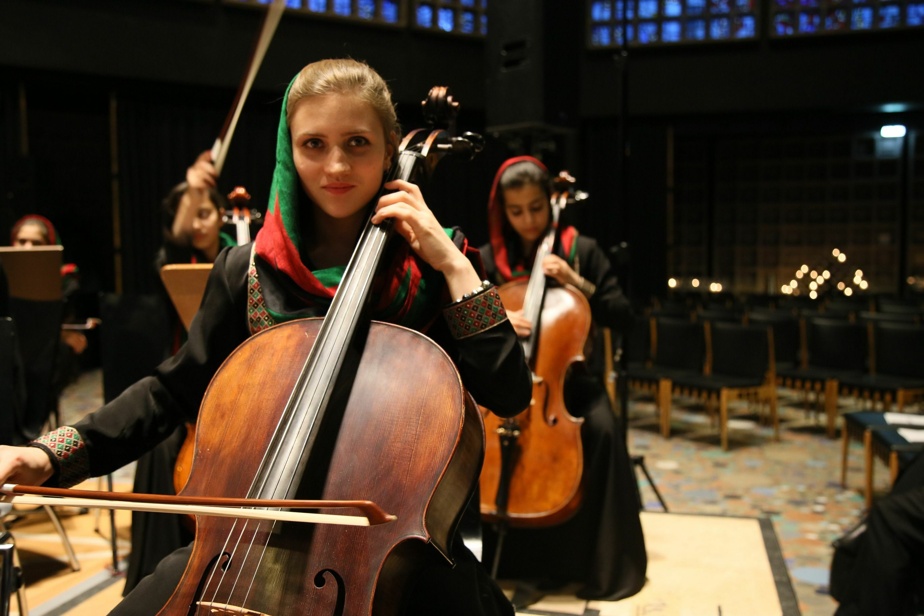Want your daughter to learn the cello? Nothing’s easier. You offer him private lessons or enroll him in a music school.
In Afghanistan, it is a little more complicated. Since the Taliban took over in 2021, music has been outright banned, because it’s considered “impure”. And this is even more true for the (rare) women who had chosen to learn an instrument, despite the risk involved.
This disturbing reality is told in the documentary Keeping the Music Alive, which has its world premiere on Saturday at the 41st Festival of Films on Art (FIFA).
Its director, the Franco-Tunisian Sarah El Younsi, focuses more particularly on the case of the first exclusively female orchestra in Afghanistan, Zohra, which had its little hour of glory before fleeing the country in disaster, in the fall of 2021. , after the return of the fundamentalists.
“It was supposed to be a film about the story of the emancipation of young Afghan girls. It became a film about the fight for their freedom, for their art, their culture. And also a film about exile, ”says the filmmaker, joined in Paris last Monday.
This two-part story begins in 2010 with the creation of the National Institute of Music of Afghanistan (ANIM) in Kabul. Its founder, Ahmad Naser Sarmast, wants to train a new generation of Afghan musicians, after the fall of the first era Taliban. Although music in Afghanistan is more of a male affair, he opens his door to girls and travels the country in search of female talent.
This vision led in 2015 to the formation of Zohra, an orchestra of 25 musicians experienced in Western instruments, but also Afghan folk, a spectacular departure from tradition.
The most conservative do not see this revolution in a good light. In 2014, a suicide attack killed 1 person and injured 15 – including Ahmad Naser Sarmast – during an ANIM student concert.
After this attack, the music school becomes one of the best guarded places in Kabul.
An emblematic figure of a progressive and visionary Afghanistan, the Zohra orchestra became the darling of Western elites. In 2017, the group performed at the Davos Economic Forum, then in half a dozen European cities. Its best students are sponsored by American patrons. Some have scholarships to study abroad. Ahmad Naser Sarmast receives the Polar Prize in Stockholm, equivalent to the Nobel for music.
But this good momentum is stopped dead in August 2021, when the Taliban regains power and completes the drive out of American troops from Kabul. The institute has long been in the crosshairs of fundamentalists; it is necessary to pack up as soon as possible, under penalty of reprisals.
From Australia, where he is for personal reasons, the director organizes an emergency escape. The school has 150 students, including several minors. How do you evacuate all these people, including teachers and parents, some of whom don’t have passports? The episode is a thriller. But with the help of cellist Yo-Yo Ma and the Qatari government, 273 people linked to ANIM left in October for Portugal, which offered them asylum. Many remain in Afghanistan, however, out of fear or lack of family support, while the music institute is transformed into a Taliban military base.
Keeping the Music Alive is about those young women who have had the courage to leave their world – their family sometimes – to pursue their musical education. This professional choice, simple in our eyes, here takes on a dramatic dimension and makes us aware of the battles waged elsewhere in the world for freedoms that we take for granted.
But they are homesick and feel guilty for being “free”, while some of their sisters are stuck in Afghanistan, where they can neither work nor play an instrument. For the latter, the prospect is now only about marriage and life in a burqa…
Between optimism and disenchantment, Keeping the Music Alive is ultimately a bittersweet film. On the one hand an Afghanistan under a leaden screed, on the other musicians in exile who miraculously continue their apprenticeship.
Glass half empty or half full?
For Sarah El Younsi, the answer is clear: “I want to tell what drives people. If we manage to tell things that bring hope, struggles and fights, they become models, sources of inspiration. But to me, this story is hopeful. It’s important to leave room for stories like that…”















